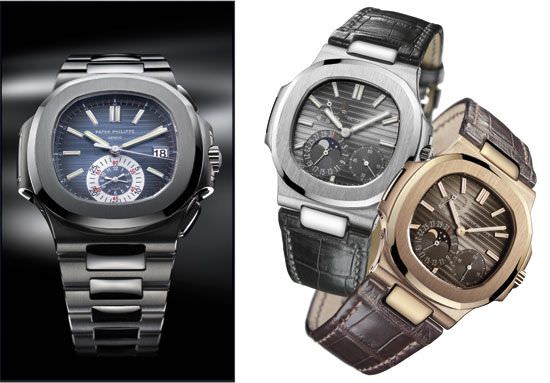
“At 30 years old, one doesn’t yet need a real facelift,” mused one of the young guests with a note of gentle irony in her voice. She was among those invited by Patek Philippe to a ‘Seventies’ party in a Geneva nightspot, which itself had been entirely redecorated for the occasion. That evening, journalists from around the world came to admire the new Nautilus, the cult model created in 1976, to which the Geneva manufacture wants to impart ‘a new momentum’.
The young woman was perfectly correct in her remark. The new Nautilus was not given a true ‘facelift’, but only a little ‘botox’ here and there. Actually, the Nautilus, designed by Gérald Genta during the full punk era, had not really become wrinkled at all, and the brand’s watchmakers only needed to give it a few minor touch ups. The two famous lateral hinges, which used to be rectangular, are now slightly curved, and the entire case has been softened lightly, with the metal bracelets giving a smoother look and feel. The ‘minor surgery’ concerns two points: the construction of the case and the addition of a new chronograph movement.

“One of the most expensive watches in the world is made of steel,” proclaimed one of the watch’s advertisements at the time. During this epoch, the Nautilus radically broke with current trends, which favoured gold and ultra-thin cases. On the contrary, the Nautilus was robust, sporty, and made of steel, and would soon establish itself as something ‘different’ (along with its ‘competitor’, the Royal Oak from Audemars Piguet, also designed by the ingenious Gérald Genta four years earlier, in 1972). The Nautilus was a modern watch, in tune with the new lifestyles, and a timepiece that could be worn for any occasion, from forceful sports to fanciful soirees.
Its sturdiness and its water-resistance were notably assured by a case that was constructed in two pieces (the monocoque caseback/middle and the bezel, which were fixed and compressed together on the two joints by four tightening screws). Current technologies, however, permit a return to the classic construction using three elements (caseback, middle, and bezel), while still maintaining the original sturdiness and water-resistance. Of the six new Nautilus models, only one, medium sized, conserves the original construction principle even though its design shows the same retouches. Another new feature is that all of the new models have a transparent sapphire crystal caseback.
The star of the new collection is without a doubt the Nautilus Chronograph Ref. 5980/1A, which is equipped with the totally new automatic flyback chronograph movement, Calibre 28-250 C, with a column-wheel mechanism, the first chronograph movement designed and built entirely in-house by Patek Philippe (for more on these technical specifications, see Europa Star issue 2/06). This exceptional movement is housed in a case that has been enlarged to 44 mm, normal by today’s standards, yet the first Nautilus, at 42 mm, was, during its time, considered by some to be a ‘monster’, and was given the nickname ‘Jumbo’. But, times have changed, and the Nautilus, now delicately re-visited, has many good decades ahead of it.
Source: Europa Star December-January 2007 Magazine Issue





